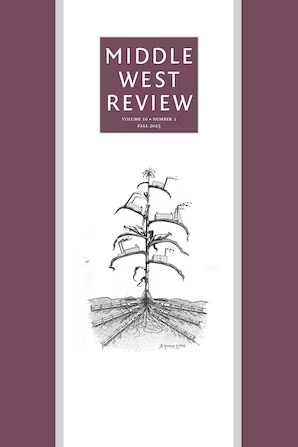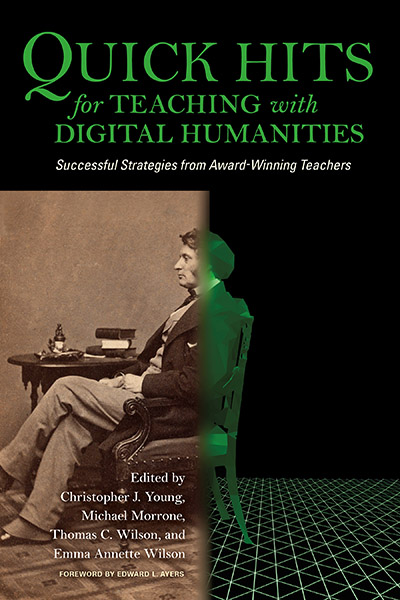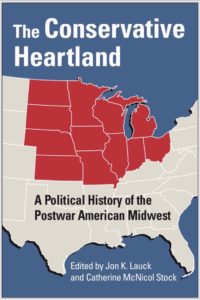“The Nature of Illinois: Storytelling, Podcasts, and the Classroom,” in Agricultural History,97, no. 4 (2023): 662-667
As a popular form of digital storytelling, podcasts allow historians to share historical research in compelling and engaging ways. They can also be helpful tools in the classroom. However unlike with traditional research papers, the production of podcasts requires students to think about audio quality, sound effects, narrative structure, and writing compelling scripts to keep a listener engaged with the research material. Creating podcasts provides students an opportunity to learn new technical skills while engaging directly with a public audience. By using agricultural and environmental stories as the central organizing themes of the classroom, students must consider how to talk about nature, ecological systems, and agricultural history in ways that attract and retain an audience. In this article I provide an overview of the ways in which I have used podcasts in the classroom, an argument for the use of podcasting as a tool for teaching, and the overall potential of podcasts to introduce diverse audiences to agricultural and environmental history.
“Unearthing the Past: A Midwestern Environmental History Symposium,” in The Middle West Review,10, no. 1 (2023): 11-15
This special issue focuses on the environmental history of the American Midwest. Compiled with Jennifer Stinson (Saginaw Valley State University), this issue brings together a group of scholars who explore topics related to industrialization, agriculture, mining, pollution, and activism throughout the region. Our opening essay outlines the contours of the issue and proposes a variety of new directions for the fields of Midwestern Studies and environmental history.
For access to the entire issue, visit the Middle West Review website at the University of Nebraska Press website: Middle West Review: An Interdisciplinary Journal about the American Midwest
“Introducing GIS in the History Classroom: Mapping the Legacies of the Industrial Era in Postindustrial America,” in The Journal of Interactive Technology and Pedagogy.
During the fall 2018 semester, I taught a coursed titled History of American Capitalism. In addition to a history of economic trends, the course examined the ways in which American capitalism has influenced a set of ideas and cultural attitudes about wealth, citizenship, identity, gender, and the use of natural resources. The course structure was mostly traditional — a blend of lecture and seminar-style discussion. Though I followed this structure for much of the semester, I intentionally designed one module to introduce students to GIS mapping. By incorporating GIS technology into the course, I introduced students to new digital tools while enabling participants to engage with the course material in a unique way in order to improve historical understanding, critical thinking, and digital literacy.
“Close Reading and Coding with the Seward Family Digital Archive: Digital Documentary Editing in the Undergraduate History Classroom,” in Quick Hits: Teaching with the Digital Humanities, edited by Christopher J. Young, Michael C. Morrone, Thomas C. Wilson, and Emma Annette Wilson, foreword by Edward L. Ayers (Bloomington, Indiana: Indiana University Press, 2020), 12 – 17.
From 2015 – 2019 I served as the Text Encoding Initiative and Technologies Manager for the Seward Family Digital Archive. During that time I was responsible for teaching undergraduate and graduate students XML coding based on the guidelines laid out by Text Encoding Initiative (TEI). In this essay, I discuss the overall structure of the course including the techniques that students used tp transcribe, annotate, and markup digital versions of nineteenth century correspondence. Additionally, I outline how this format encouraged a deeper understanding of course content through a close reading of the primary source material. Lastly, I discuss how the the integration of digital tools into the classroom can enhance student learning and offer opportunities for participants to contribute to larger digital humanities project.
“A New ‘State of Superior’: Political Fracture and Anti-Environmentalism in the Upper Midwest,” in The Conservative Heartland: A Political History of the Postwar American Midwest, ed. John Lauck and Catherine McNicol Stock (Lawrence, Kansas: University Press of Kansas, 2020), 153 – 170.
In the late 1960s and through the 1970s, modern environmentalism reshaped the political landscape of the Upper Midwest. For many residents of the region’s mining communities, the environmental movement threatened the core industries of the region. Those in the region viewed the new policies as direct threats to the economic and social fabric of the region. In response to new environmental legislation, many in the region prepared to take political action. They planned to secede and form a new State of Superior as a haven from the environmentalists and their legislation. Ignoring the very real ecological issues they faced, those in the region ultimately realigned their political allegiances fearing larger economic collapse in the midst of a larger environmental movement.
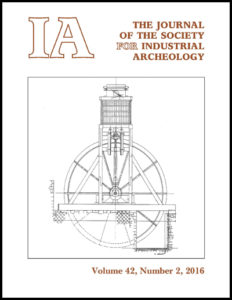 “A New, Historic Canal: The Making of an Erie Canal Heritage Landscape,” in IA: The Journal for the Society of Industrial Archaeology 42, no. 2 (2016): 23 – 34.
“A New, Historic Canal: The Making of an Erie Canal Heritage Landscape,” in IA: The Journal for the Society of Industrial Archaeology 42, no. 2 (2016): 23 – 34.
The Erie Canal was an engineering marvel when it was constructed in the early-nineteenth century. Expanding commercial opportunities to the interior of the continent, the canal quickly became a symbol of economic prosperity for those whose lives were connected to the landscape. Despite its once prominent place in the American mind, changes in transportation throughout the twentieth century left the Erie Canal as a symbol of the past rather than an economic reality. Fearing that the Erie Canal had lost its prominence in the American mind, local residents as well as state and national politicians began a series of heritage-tourism initiatives to rebuild and rebrand the historic canal landscape. This article examines the history of the formation of the Erie Canalway National Heritage Corridor as foundational shift in the cultural landscape. By distributing grants, cultivating tourism, and redefining the space as a heritage landscape, government agencies and regional residents fundamentally transformed the very meaning of the Erie Canal landscape in the minds of Americans.
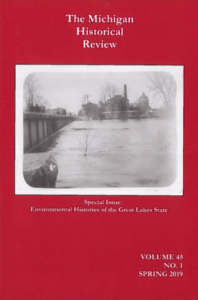 “Scrolling Through Nature: Reflections on the Digital Humanities and Michigan’s Environmental History,” in The Michigan Historical Review 45, no. 1 (2019): 109-119.
“Scrolling Through Nature: Reflections on the Digital Humanities and Michigan’s Environmental History,” in The Michigan Historical Review 45, no. 1 (2019): 109-119.
This essay outlines the recent growth of the digital humanities in academia and its implications for the study of Michigan’s environmental history. With the proliferation and accessibility of digital tools to create, share, and analyze historical information, librarians and scholars are finding new ways to examine and publish aspects of the state’s environmental history. The essay tracks the genealogy of various digital history projects underway at several Michigan’s colleges and universities and offers direction for the future of the nascent field.
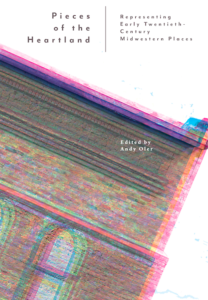 “In the Land of Hiawatha: Conservation and Literary Sociability in Michigan,” in Pieces of the Heartland: Representing Midwestern Places, edited by Andy Oler (Hastings, Nebraska: Hastings College Press, 2018), 23 – 38.
“In the Land of Hiawatha: Conservation and Literary Sociability in Michigan,” in Pieces of the Heartland: Representing Midwestern Places, edited by Andy Oler (Hastings, Nebraska: Hastings College Press, 2018), 23 – 38.
In the late nineteenth and early twentieth centuries, Michigan was a landscape scarred by the blunt forces of industrialization. Decades of mining and logging devastated the region’s ecosystems triggering a political and environmental movement. Hoping to protect their revered landscapes from further decline, conservationists and outdoorsmen harnessed the words of Henry Wadsworth Longfellow’s The Song of Hiawatha – it became the language of environmental reform. Through a process of literary sociability, conservationists remade the ecological realities of Michigan’s landscapes by connecting the forests, rivers, lakes, and streams with the characters and places found in Longfellow’s iconic poem. The following essay tracks the cultural influence Longfellow’s poem as well as its environmental implications throughout the twentieth century.
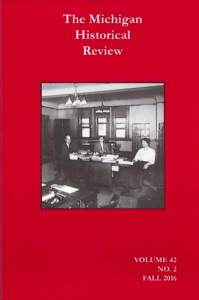 “Imagining a Pure Michigan Landscape: Advertisers, Tourists, and the Making of Michigan’s Northern Vacationlands,” in The Michigan Historical Review 42, no. 2 (2016): 31-51.
“Imagining a Pure Michigan Landscape: Advertisers, Tourists, and the Making of Michigan’s Northern Vacationlands,” in The Michigan Historical Review 42, no. 2 (2016): 31-51.
In the second half of the nineteenth century, a wave of urban tourists remade Michigan’s northern landscapes. Rather than a region of economic extraction, visitors imagined northern Michigan as a healthful remedy or haven to avoid the pressures of urbanity. Supported by railroad and steamship companies, tourists shaped the landscapes to answer their cultural concerns. Through conservation efforts and new environmental appreciation, vacationers redefined this region of the state—often at the expense of local inhabitants. A history of Michigan’s tourist landscapes provides a lens to view how cultural motivations imprint themselves onto the environment. Today, residents of Michigan come to expect certain pristine or “pure” environments. However, the history of Michigan’s vacationlands reveals that those places are constructed to reflect the imaginative desires of tourists and advertisers.
Op-Eds, Commentaries, and Other Writings
“Jim Harrison—Osceola County, MI,” New Territory Magazine: Literary Landscapes v.12, October 4, 2023, https://newterritorymag.com/literary-landscapes/jim-harrison-osceola-county-michigan/.
“‘All-In’ – Professors on the Picket Line at Eastern Illinois,” Belt Magazine, April 10, 2023, https://beltmag.com/all-in-professors-on-the-picket-line-at-eastern-illinois-university/ .
“(Senator) Paul Simon’s American Tune,” Belt Magazine, November 2, 2022, https://beltmag.com/senator-paul-simons-american-tune/”.
“The Making of ‘Pure Michigan,’” Edge Effects, November 8, 2016, http://edgeeffects.net/pure-michigan/.

